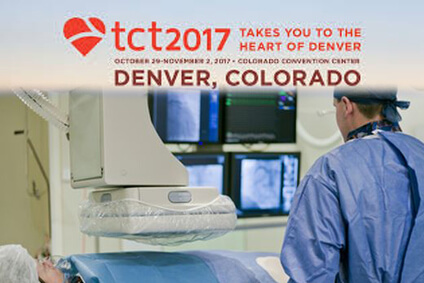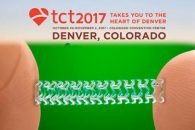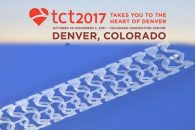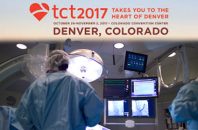Courtesy of SBHCI. Angioplasty in patients with chronic stable angina and functionally significant lesions improves clinical outcomes and quality of life over the long term, as compared with optimal medical therapy alone. Furthermore, the invasive approach becomes more cost-effective as the years go by. Previously, FAME 2 had shown that angioplasty was initially more expensive, but…
TCT 2017 | ORBITA: The Placebo Effect of Angioplasty
Courtesy of the SBHCI. Chronic stable angina and severe coronary lesion patients who undergo angioplasty in a single vessel show no better outcomes than individuals who undergo a placebo sham procedure when it comes to exercise capacity and symptoms, according to this study presented at TCT and published simultaneously in the Lancet. The curious results…
TCT 2017 | SENIOR: DES with a Bioresorbable Polymer and Short Dual Antiplatelet Therapy in Elderly Patients
Courtesy of the SBHCI. This study sought to assess the safety and efficacy of an everolimus-eluting stent with a biodegradable polymer (SYNERGY II) vs. a conventional stent (REBEL) in patients >75 years old with short duration of dual antiplatelet therapy. Before randomization, investigators recorded the planned duration of dual antiplatelet therapy (1 month for stable patients and 6 months…
TCT 2017 | REDUCE: 3 vs 12 Months of Dual Antiplatelet Therapy with the New Combo DES
Courtesy of SBHCI. This new device has, on one hand, an abluminal sirolimus coating, and on the other hand, a luminal CD34 antibody coating for EPC capturing, to potentially accelerate post-PCI reendothelization. Between 2014 and 2016, the study included 1496 patients undergoing acute coronary syndrome (ACS), receiving the new COMBO stent. These patients were randomized…
ABSORB III: after 3 Years, the Bioresorbable Scaffold is Still a Disappointment
Courtesy of the SBHCI. The 3-year outcomes of the ABSORB III trial, which randomized 2008 patients 2:1 to an everolimus eluting bioresorbable scaffold (1322 patients) vs. a metallic stent with permanent everolimus eluting polymer (686 patients), was published with low profile and great disappointment. Primary end-point, a composite of target vessel failure, occurred in 13.4% of patients receiving…
Absorb IV: Bioresorbable Scaffolds with an Optimized Implantation Technique
Courtesy of the SBHCI. The Absorb IV trial randomized 2604 patients in a 1:1 ratio to receive an Absorb everolimus-eluting bioresorbable scaffold or a Xience stent. With the aim of minimizing the problems observed in previous studies, the Absorb IV protocol excluded small caliber (<2.5 mm) vessels and included mandatory aggressive pre-dilation followed by non-complacent balloon post-dilation. Patients could…
ABSORB II: No Benefits from Scaffolds After Complete Bioresorption
Courtesy of the SBHCI. The ABSORB II study sought to assess the mechanical properties of everolimus-eluting bioresorbable scaffolds, such as the increase in minimal lumen area and the recovery of the vasomotor properties of the treated artery. Last year saw the publishing of negative results for the primary endpoints, registering a higher rate of complications at…
DKCRUSH-V: What Is Simple Is Not Always Best for the Left Main Coronary Artery
Courtesy of the SBHCI. Angioplasty of true distal left main bifurcation lesions with a double-kissing (DK) crush two-stent strategy, compared with provisional stenting, results in lower rates of target lesion failure at 1 year. These findings were largely driven by lower rates of target vessel infarction and definite/probable stent thrombosis. Read also: “EXCEL-QOL Substudy: Similar Quality…
EXCEL-QOL Substudy: Similar Quality of Life both with CABG and Left Main PCI
Courtesy of SBHCI. According to a new quality of life sub-study, the “EXCEL”, both coronary artery bypass graft and left main PCI are associated with significant clinical improvement in terms of angina frequency, tolerance to exertion and treatment satisfaction. At 12 and 36 months, there were no significant differences between PCI and surgery after several quality of…
HREVS: Hybrid Revascularization Offers No Advantage in Multivessel Disease
Courtesy of SBHCI. Hybrid revascularization, which combines CABG with PCI, failed to reduce myocardial ischemia and major cardiac and cerebrovascular events, compared to cardiac artery bypass graft or PCI separately. However, this small study does not provide conclusive evidence, which calls for further randomized studies with enough statistical power to answer this question. Fortunately, we won’t have…
CULPRIT-SHOCK Results Will Transform Guidelines and Clinical Practice
Courtesy of the SBHCI. After treating the culprit lesion in patients with acute myocardial infarction complicated by cardiogenic shock, continuing revascularization of all other lesions worsens outcomes. This finding of the CULPRIT-SHOCK trial has changed entirely the way we treated this patient group and will surely modify guidelines. Culprit-lesion treatment with the option to perform…
- 1
- 2










